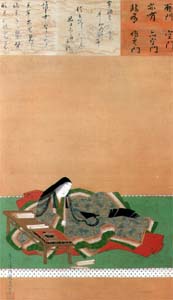Takeshi Asai's Japanese Newsletter - Y2K
 In Japan, where only one percent of the population is Christian and the majority of people consider themselves Buddhists, the advent of the new millennium has little significance. In fact, the idea of a millennium was unfamiliar until the book, Millennium: A History of the Thousand Years by Felipe Fernandez-Armesto was published in 1996. Fernandez-Armesto distinguishes the publication of Genji-monogatari (the Tale of Genji), the world-famous Japanese classic written by Shikibu Murasaki, as the first event occurring in this millennium.
In Japan, where only one percent of the population is Christian and the majority of people consider themselves Buddhists, the advent of the new millennium has little significance. In fact, the idea of a millennium was unfamiliar until the book, Millennium: A History of the Thousand Years by Felipe Fernandez-Armesto was published in 1996. Fernandez-Armesto distinguishes the publication of Genji-monogatari (the Tale of Genji), the world-famous Japanese classic written by Shikibu Murasaki, as the first event occurring in this millennium.
When Shikibu Murasaki--designated by UNESCO in 1964 as one of the world's greatest people--launched her 54-chaptered romantic tale in Kyoto in 1001, nobody in Japan knew that it was the beginning of the second millennium. For them, it was just Choho 3, the third year of the Choho period, because the Japanese calendar measures time according to the reigns of its emperors. For instance, 1999 is Heisei 11, meaning the current Emperor Akihito has reigned for 11 years.
Christianity was introduced to Japan in 1549 (although it was soon banned). Consequently, the Western calendar was never officially incorporated until very recently, when computers began to play an active role in daily lifestyles. Despite the clumsiness of the traditional calendar--Shikibu Murasaki was born in Ten-en 1 and died in Chogen 4. Can you figure out how long she lived?--the Japanese maintained the tradition.
Even though Japan had isolated itself from Christianity and the Western calendar, the two different religions shared a common denominator. Mappo, the Buddhist idea of the end of the world, is similar to the Western idea of doomsday or the biblical Book of Revelations, which prophesizes the destruction of the world. Two thousand years after the death of Buddha, people believed Buddhism would perish and chaos would rule the world for 10,000 years until one Miroku Bosatsu emerged as a savior; 1052 was believed to be the year Mappo would begin. In fact, when Shikibu Murasaki died at the age of 58 in 1031, the prosperity of the Heian period had already passed. Toward the end of the era, all kinds of disasters--famines, droughts, floods, earthquakes, and plagues--were horrendous enough to make everybody, from emperors to peasants, believe that Mappo was surely approaching. Even Yorimichi Fujiwara, an 11th century equivalent of a prime minister, built the Amida Hall at the exquisitely beautiful Byodo Temple in Uji in an effort to save his country from Mappo.
We can only guess how the people felt as they approached 1052, but historians are certain Mappo was a nation-wide threat. So far, nobody has ever heard of today's prime minister building temples to prepare for another nation-wide threat called Y2K. Instead, the Japanese government has proclaimed the year 2000 the end of the 20th century and 2001 the start of the 21st century (in accordance with the Greenwich Royal Observatory's decree that the first year of a millennium begins with number one, not zero). The government has issued a stern warning to every business to prepare for computer-related disasters. MITI (Ministry of International Trade and Industry), for instance, installed a 2000 nen kauntodaun kurokku (The Year 2000 Countdown Clock), in its main lobby, but the clock never mentions a celebration; it only says, "Is your computer ready for the year 2000?" The policymakers of the Japanese Big Bang project, a major financial overhaul launched in April 1998 by former Prime Minister Ryutaro Hashimoto, have targeted its completion by 2001.
Rather than celebrating the year 2000, the Japanese people are cautious about computer-related catastrophes. For the modern Japanese who cannot possibly live without computers, the year 2000 is not a celebration at all. It's a modern version of Mappo.
published as Japanese Monthly, April/May 1999 issue
edited by Marcia Allen
Back to Japanese Newsletters Home Page
Back to Top Page of Takeshi Asai's Website
 In Japan, where only one percent of the population is Christian and the majority of people consider themselves Buddhists, the advent of the new millennium has little significance. In fact, the idea of a millennium was unfamiliar until the book, Millennium: A History of the Thousand Years by Felipe Fernandez-Armesto was published in 1996. Fernandez-Armesto distinguishes the publication of Genji-monogatari (the Tale of Genji), the world-famous Japanese classic written by Shikibu Murasaki, as the first event occurring in this millennium.
In Japan, where only one percent of the population is Christian and the majority of people consider themselves Buddhists, the advent of the new millennium has little significance. In fact, the idea of a millennium was unfamiliar until the book, Millennium: A History of the Thousand Years by Felipe Fernandez-Armesto was published in 1996. Fernandez-Armesto distinguishes the publication of Genji-monogatari (the Tale of Genji), the world-famous Japanese classic written by Shikibu Murasaki, as the first event occurring in this millennium.